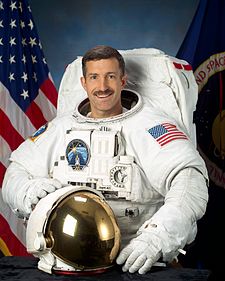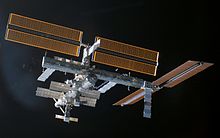Daniel Burbank
| Daniel Christopher Burbank | |
|---|---|
 | |
| Astronaut NASA | |
| Státní příslušnost | USA |
| Datum narození | 27. července 1961 (61 let) |
| Místo narození | Manchester, Connecticut, USA |
| Předchozí zaměstnání | Letec Pobřežní stráže |
| Hodnost | Kapitán pobřežní stráže |
| Čas ve vesmíru | 188 dní, 21 hodin a 49 minut |
| Kosmonaut od | 1. května 1996 |
| Mise | STS-106/ISS STS-115/ISS Expedice 29/30 (Sojuz TMA-22/ISS) |
| Znaky misí | |
| Kosmonaut do | dosud aktivní |
| Některá data mohou pocházet z datové položky. | |
Daniel Christopher Burbank (* 27. července 1961 Manchester, Connecticut, USA) původně pilot pobřežní stráže Spojených států, je od května 1996 astronautem NASA. Má za sebou dva krátkodobé kosmické lety raketoplánem na Mezinárodní vesmírnou stanici (ISS), které trvaly 23 dní, 14 hodin a 19 minut. Od roku 2009 se připravoval na dlouhodobý let na Mezinárodní vesmírné stanici (ISS), jako palubní inženýr Expedice 29 a velitel Expedice 30. Do vesmíru vzlétl 14. listopadu 2011 v lodi Sojuz TMA-22, přistál 27. dubna 2012.
Život
Pilot
Daniel Burbank se narodil v Manchesteru ve státě Connecticut, dětství a mládí prožil v nedalekém městě Tolland, zde také do roku 1979 navštěvoval střední školu. Potom studoval na Akademii pobřežní stráže (U.S. Coast Guard Academy), roku 1985 zde získal titul bakaláře elektrotechniky.[1]
Od května 1985 sloužil na lodi Gallatin WHEC-721 Pobřežní stráže Spojených států. Od ledna 1987 do února 1988 prodělal letecký výcvik na základně Pensacola na Floridě. Poté létal na vrtulnících (HH-3F Pelican a HH-60J) u jednotek pobřežní stráže v Jižní Karolíně a Massachusetts. Roku 1990 vystudoval letectví na Embry-Riddle Aeronautical University. Pokračoval ve službě v pobřežní stráži, už jako pilot-instruktor, od roku 1995 na Aljašce. Celkem nalétal, především na vrtulních, přes 4000 hodin. Zúčastnil se přes tří set záchranných operací.[1]
Astronaut
Zúčastnil se 14. a 15. náboru astronautů NASA v letech 1991–1994, ale dostal se vždy pouze mezi stovku finalistů. Uspěl až v 16. náboru a 1. května 1996 byl začleněn do oddílu astronautů NASA. V ročním kurzu všeobecné kosmické přípravy získal kvalifikaci letového specialisty raketoplánu Space Shuttle.[2]
Po dokončení přípravy pracoval v NASA, pracoval v oddělení pro Mezinárodní vesmírnou stanici (ISS), působil jako hlavní spojař s posádkami kosmických lodí (Capcom), služebně často pobýval v Rusku.[1]
V únoru 2000 byl jmenován jedním z letových specialistů mise STS-106. Let STS-106 byl zahájen 8. září 2000 startem raketoplánu Atlantis. Astronauté přivezli na zárodek ISS zásoby a materiál nutný pro trvalé obydlení stanice, které bylo zahájeno už za několik týdnů (2. listopadu 2000, Expedicí 1). Atlantis přistál 20. září 2000 po 11 dnech, 19 hodinách a 12 minutách pobytu ve vesmíru.[3] Tímto letem se stal 394 člověkem ve vesmíru.

V únoru 2002 byl jmenován letovým specialistou mise STS-115, jejíž start byl naplánován na jaro 2003. Po havárii Columbie byl let odložen.[2] Do vesmíru se posádka mise STS-115 dostala v raketoplánu Atlantis až ve dnech 9. – 21. září 2006. Astronauté pokračovali ve výstavbě ISS – přivezli a připojili nosníky P3/P4 a sluneční panely na nich upevněné. Burbank v průběhu montáže vystoupil do otevřeného vesmíru na 7 hodin a 11 minut. Po splnění úkolů astronauté přistáli na mysu Canaveral. Let trval 11 dní, 19 hodin a 7 minut.[4]
V lednu 2007 byl přeřazen mezi astronauty-manažery, pracoval v Akademii pobřežní ochrany. Od ledna 2009 se opět vrátil mezi aktivní astronauty. V červenci 2009 byl zařazen do posádky Expedice 29 se startem v září 2011.[2] V říjnu 2009 NASA jeho zařazení do Expedice 29 potvrdila.[5]
Po havárii Progressu M-12M byl start Expedice 29 v Sojuzu TMA-22 odložen. Ke svému třetímu vesmírnému letu odstartoval v lodi Sojuz TMA-22 z kosmodromu Bajkonur 14. listopadu 2011 ve 4:14 UTC ve funkci palubního inženýra lodi společně s Antonem Škaplerovem a Anatolijem Ivanišinem. Po dvoudenním letu se 16. listopadu Sojuz spojil s Mezinárodní vesmírnou stanicí. Po pěti měsících práce na ISS trojice 27. dubna 2012 přistála v Kazachstánu.[6]
Lety v kostce
- STS-106 Atlantis (raketoplán) (8. září 2000 – 20. září 2000), specialista
- STS-115 Atlantis (9. září 2006 – 21. září 2006), specialista
- Sojuz TMA-22 14. listopadu 2011 – 27. dubna 2012, palubní inženýr
Daniel Burbank je ženatý, má dvě děti.[1]
Odkazy
Reference
- ↑ a b c d Biographical data. Daniel C. Burbank [online]. Houston: NASA, rev. 2009-08 [cit. 2009-11-03]. Dostupné online. (anglicky) – Oficiální biografie NASA
- ↑ a b c IVANOV, Ivan, a kol. Космическая энциклопедия ASTROnote [online]. Moskva: rev. 2009-10-13 [cit. 2009-11-03]. Kapitola Daniel Christopher Burbank. Dostupné online. (rusky)
- ↑ HOLUB, Aleš. MEK. Malá encyklopedie kosmonautiky [online]. Rev. 2000-09-21 [cit. 2009-11-01]. Kapitola STS-106 At/F-22. [dále jen Holub]. Dostupné online.
- ↑ Holub. Rev. 2006-09-23 [cit. 2009-11-01]. Kapitola STS-115 At/F-27.
- ↑ YEMBRICK, John; CLOUTIER-LEMASTERS, Nicole. Release: 09-233. NASA and its International Partners Assign Space Station Crews [online]. Washington, Houston: NASA, 2009-10-07 [cit. 2009-10-30]. Dostupné online. (anglicky)
- ↑ HOLUB, Aleš. MEK. Malá encyklopedie kosmonautiky [online]. Praha: rev. 2011-11-14 [cit. 2011-11-16]. Kapitola Sojuz TMA-22. Dostupné online.
Externí odkazy
 Obrázky, zvuky či videa k tématu Daniel Burbank na Wikimedia Commons
Obrázky, zvuky či videa k tématu Daniel Burbank na Wikimedia Commons - Na webu Space
- Na webu MEK-Kosmo
Média použitá na této stránce
This view of the International Space Station, backdropped against the blackness of space, was taken shortly after the Space Shuttle Atlantis undocked from the orbital outpost at 7:50 a.m. CDT. The unlinking completed six days, two hours and two minutes of joint operations with the station crew. Atlantis left the station with a new, second pair of 240-foot solar wings, attached to a new 17.5-ton section of truss with batteries, electronics and a giant rotating joint. The new solar arrays eventually will double the station's onboard power when their electrical systems are brought online during the next shuttle flight, planned for launch in December.
The International Space Station (ISS) program is completing the transition from assembly to full utilization as humankind celebrates the golden anniversary of human space exploration. In recognition of these milestones and especially of the contribution of those whose dedication and ingenuity make spaceflight possible, a fully assembled ISS is depicted rising above a sunlit Earth limb. Eastward of the sunlit limb, the distinctive portrayal of Earth's surface illuminated by nighttime city lights is a reminder of mankind's presence on the planet, most readily apparent from space only by night, and commemorates how human beings have transcended their early bonds throughout the previous 50 years of space exploration. The ISS, a unique space-based outpost for research in biological, physical, space and Earth sciences, in the words of the crew members, is an impressive testament to the tremendous teamwork of the engineers, scientists and technicians from 15 countries and five national space agencies. The six crew members of Expedition 30, like those who have gone before them, express that they are honored to represent their countries and the ISS team in conducting research aboard the station and adding to the body of knowledge that will enable the world's space faring countries to more safely and more productively live, work and explore outer space, paving the way for future missions beyond low Earth orbit, and inspiring young people to join in this great adventure.
This is the crew patch for the STS-106 mission, which is the first Shuttle flight to the International Space Station since the arrival of its newest component, the Russian-supplied Service Module Zvezda (Russian for star). Zvezda is depicted on the crew patch mated with the already orbiting Node 1 Unity module and Russian-built Functional Cargo Block, called Zarya (sunrise), with a Progress supply vehicle docked to the rear of the Station. The International Space Station is shown in orbit with Earth above as it appears from the perspective of space. The Astronaut Office symbol, a star with three rays of light, provides a connection between the Space Shuttle Atlantis and the Space Station, much the same as the Space Shuttle Program is linked to the International Space Station during its construction and future research operations. Stylized versions of flags from Russia and the United States meet at the Space Station. They symbolize both the cooperation and joint efforts of the two countries during the development and deployment of the permanent outpost in space as well as the close relationship of the American and Russian crew members.
On the Expedition 29 patch, the International Space Station (ISS) is shown following the path of the historic 18th century explorer, Captain James Cook, and his ship, Endeavour. During Cook's three main voyages, he explored and mapped major portions of the oceans and coastlines under the flight path of the ISS and added immeasurably to the body of knowledge of that time. As the ISS sails a stardust trail – following the spirit of Endeavour sailing toward the dark unknown and new discoveries – it enlightens Earth below. Through the centuries, the quest for new discoveries has been a significant element of the human character, inspiring us to endure hardships and separation to be part of a mission which is greater than any individual. A spokesman for the crew stated, "The crew of Expedition 29 is proud to continue the journey in this greatest of all human endeavors."
This is the STS-115 insignia. The patch was designed by Graham Huber, Gigi Lui, and Peter Hui in conjunction with York University in Toronto, Canada. This mission continues the assembly of the International Space Station (ISS) with the installation of the truss segments P3 and P4. Following the installation of the segments utilizing both the shuttle and the station robotic arms, a series of three space walks will complete the final connections and prepare for the deployment of the station's second set of solar arrays. To reflect the primary mission of the flight, the patch depicts a solar panel as the main element. As the Space Shuttle Atlantis launches towards the ISS, its trail depicts the symbol of the Astronaut Office. The starburst, representing the power of the sun, rises over the Earth and shines on the solar panel. The shuttle flight number 115 is shown at the bottom of the patch, along with the ISS assembly designation 12A (the 12th American assembly mission). The blue Earth in the background reminds us of the importance of space exploration and research to all of Earth's inhabitants. The NASA insignia design for shuttle flights is reserved for use by the astronauts and for other official use as the NASA Administrator may authorize. Public availability has been approved only in the forms of illustrations by the various news media. When and if there is any change in this policy, which is not anticipated, the change will be publicly announced.





